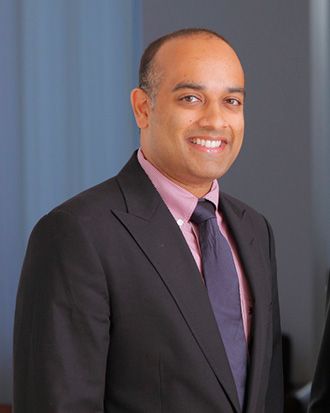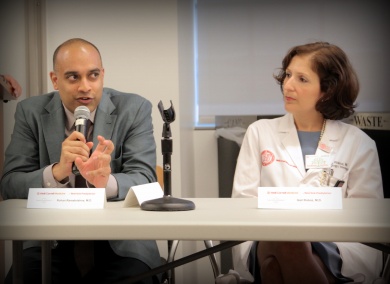Ending cancer as we know it
This post by Rohan Ramakrishna, M.D., first appeared on the Weill Cornell Brain and Spine Center blog. Read the original here.
Last week the Cancer Moonshot Task Force released its official recommendations for achieving the lofty goal set out in President Obama’s State of the Union address in January: ending cancer as we know it. I am convinced we can do it, but we need more than recommendations. We must act.
At no time in our history have we had the necessary confluence of passion, technology, human capital, and knowledge to effect substantial improvements in the lives of patients with oncologic disease – until now. The Cancer Moonshot campaign epitomizes the sort of leadership necessary to coalesce resources around this worthy public goal, so we need to seize this moment to make the advances we are so well positioned to make. We started this process in June, when Weill Cornell was one of dozens of sites around the country to host a Cancer Moonshot Summit. With the recommendations now final, it’s time to get going.
As a neuro-oncologic surgeon, I am on the front lines every day treating patients with brain malignancies. For some of these cancers, there have been millions of dollars spent on research, and countless clinical trials executed, but the survival needle has barely moved. This is not to say these efforts were in vain; indeed, amazing biologic knowledge has been gained about these cancers over the past years. We have just not had the tools or knowledge to make meaningful progress in the past. Now we can, as long as the last few pieces fall into place.
First, the government should significantly increase National Institutes of Health (NIH) funding. From 2003-2015, the NIH lost significant purchasing power due to budget cuts, sequestration, and inflationary losses. This reduced funding means fewer grants awarded, and less money generally available for scientists to pursue research. There has been a recent increase in the NIH budget, but not enough to really accelerate research in a meaningful way. As the nation’s prime distributor of medical research dollars, the NIH has the infrastructure and know-how to efficiently and fairly allocate funds to worthy research projects, investigators, and trainees. Academic centers have attempted to circumvent these national funding constraints by aggressively pursuing private philanthropic support. While private donations are of course welcome, these donations are by their nature unsteady and cannot be counted upon for ongoing research missions.
Second, support for physician-scientists needs to be dramatically increased. No one perceives the clinical limitations of current cancer therapy better than treating physicians who see patients every day. These same physicians who also wish to have a research program should be encouraged and cultivated in greater numbers. The NIH indeed has programs designed to this effect, but funding for these opportunities needs to be scaled up dramatically. Because of the extreme competition in securing federal grants due to funding constraints, the ability to secure research funding is harder than ever forcing many promising scientists to abandon their research projects altogether. In addition, clinical care needs to be more efficient so that physicians can spend more time actually treating patients with cancer. Whether the issues are overly demanding electronic health records systems, or seemingly unending recertification and education requirements, the administrative burden placed upon practicing physicians needlessly takes away from patient care and research.
Third, more patients need to enroll in clinical trials. It is estimated that less than 1 percent of eligible patients actually enroll in a clinical trial. Furthermore, with the ongoing molecular characterization of tumors in the national Precision Medicine Initiative, patients may no longer be enrolled in trials based on simple pathology but on the certain genotypic characteristics of their individual tumor. These sorts of trials are going to require more patients than ever to be successful. The reasons for poor trial enrollments are multi-factorial, but a major contributor is access. Most cancer care happens in local communities, not major academic hospitals or designated cancer centers. As such, awareness of and access to available clinical trials are limited. Regulations and trial designs should be modified to allow partnerships between major cancer treatment centers and local communities so that more patients have access to available trials.
Fourth, the bench to bedside time of new discoveries needs to be substantially improved. Some of the new therapies just coming online now for certain cancers were discovered in the lab in the early 1990s. Myriad factors contribute to this delay, such as the costs and regulatory hurdles of bringing new drugs to market. While safety and good science are the first priority in advancing new therapies through the drug discovery process, it must be kept in mind that our current therapies for cancer still mostly result in death. We need faster progress.
It is true that the treatment options available for cancer in 2016 are better than they ever have been. The success of immunotherapy for melanoma is one example of the triumph of coordinated basic science, physician and industry partnerships. In other cancers, however, our results are still pitifully poor — and glioblastoma is the perfect example. I see patients with glioblastoma far too often, and the treatments I have available for them are simply not sufficient for the task.
Progress will require sustained focus, and the moonshot metaphor is thus apt. Let’s hope, like the original moonshot of the 1960s demonstrated, that the commitment of sustained resources is what will power the progress we desperately need.




